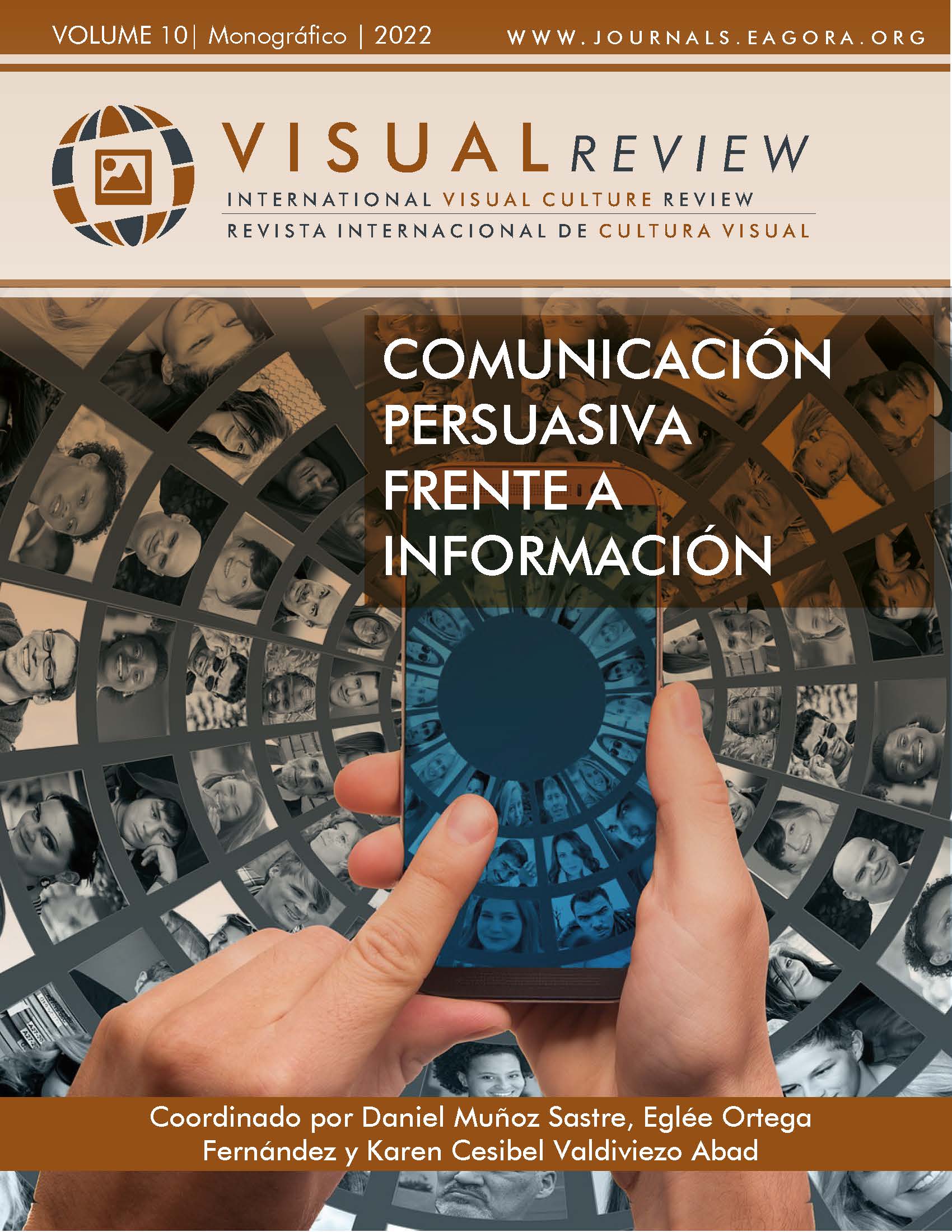Analysis of the legal context in advertising generated by influencers on Instagram
DOI:
https://doi.org/10.37467/revvisual.v9.3570Keywords:
Instagram, Influencer, Disclosure, Advertising, Covert advertising, Law, RegulationAbstract
The advertising activities carried out by influencers on Instagram are integrated into the content, causing the audience to often be unaware of the persuasive intent. For this reason, the platform has developed specific regulations and governments have created laws that regulate this practice. In the study carried out on the legislation in Spain, the United States, Germany, the United Kingdom and Japan, few differences have been found between countries, some being more restrictive than others. Most of them emphasize the importance of using sufficiently descriptive and clear words adapted to the specific format of the message.
Downloads
References
ASA (2010). Code of Non-broadcast Advertising and Direct & Promotional Marketing. https://cutt.ly/kZIsRRF
ASA (2019). The labelling of influencer advertising. https://cutt.ly/sZIpdp2
Autocontrol, & Asociación Española de Anunciantes. (2020). Código de Conducta sobre el uso de Influencers en la Publicidad. https://cutt.ly/rZIpbCk
Boerman, S. C., van Reijmersdal, E. A., & Neijens, P. C. (2012). Sponsorship Disclosure: Effects of Duration on Persuasion Knowledge and Brand Responses. Journal of Communication, 62(6), 1047-1064. DOI: https://doi.org/10.1111/j.1460-2466.2012.01677.x
Brandmanic (2018). Estudio sobre marketing de influencers en España. https://cutt.ly/GZIasdl
Bundesgerichtshof. (9 de septiembre de 2021). Bundesgerichtshof zur Pflicht von Influencerinnen, ihre Instagram-Beiträge als Werbung zu kennzeichnen. https://cutt.ly/4ZIseyR
Castelló Martínez, A., & del Pino Romero, C. (2015). Prescriptores, marcas y tuits El marketing de influencia. ADResearch ESIC International Journal of Communication Research, 12(12), 86-107. https://doi.org/10.7263/adresic-012-05 DOI: https://doi.org/10.7263/adresic-012-05
De Veirman, M., & Hudders, L. (2020). Disclosing sponsored Instagram posts: the role of material connection with the brand and message-sidedness when disclosing covert advertising. International Journal of Advertising, 39(1), 94-130. https://doi.org/10.1080/02650487.2019.1575108 DOI: https://doi.org/10.1080/02650487.2019.1575108
Díez, F. (2018). El régimen jurídico de los “influencers”. LinkedIn. https://cutt.ly/IZIdrXa
Directiva 2005/29/EC del Parlamento Europeo (2005). Diario Oficial de la Unión Europea, 11 de mayo de 2005. https://cutt.ly/WZIzxJX
Dueñas, P., Domínguez, C., & Coronil, A. (2020). El influencer marketing y el proceso de compra de los estudiantes universitarios. En J. M. Muntané & C. Sánchez (Eds.), Las Redes Sociales Como Herramienta de Comunicación Persuasiva (pp. 91–106). McGraw Hill. https://cutt.ly/qZId4wF
El Qudsi, I. (14 de enero de 2022). The State of the Influencer Marketing: Top Insights for 2022. Forbes Agency Council. https://cutt.ly/XZIf2VR
Friestad, M., & Wright, P. (1994). The Persuasion Knowledge Model: How People Cope with Persuasion Attempts. Journal of Consumer Research, 21(1), 1-31. https://cutt.ly/aZIgpgn DOI: https://doi.org/10.1086/209380
FTC (2013). Guides Concerning the Use of Endorsements and Testimonials in Advertising. https://cutt.ly/eZIgnJi
FTC (2019). Disclosures 101 for Social Media Influencers. https://cutt.ly/QZIgAyi
Hootsuite (2022a). Digital 2022. https://cutt.ly/dZIgLaX
Hootsuite (2022b). Tendencias en Redes sociales 2022. https://cutt.ly/AZIgVxe
IAB Spain (2022). Estudio de redes sociales 2022. https://cutt.ly/XZIg3rZ
Japanbuzz (2018). Best paid promotion hashtag to use japanese influencer campaigns. https://cutt.ly/gZIhpTx
Kantar Media (2020). Dimension 2020: Media&Me. https://cutt.ly/1ZIhHus
Kasahara, K. (2021). Advertising & Marketing in Japan. Law Business Research. https://cutt.ly/5ZIjqoA
Kyle (2020). The complete guide to Japanese Instagram. Plus Alpha Digital. https://cutt.ly/OZIjdCg
Laohasukkasem, P., Nurittamont, W., & Sawatmuang, P. (2021). The Impact of Online Influencers on Consumers’ Purchase Intention of Japanese Food in Bangkok. Journal of Management in Business, Healthcare and Education, 1(1), 1-26- https://ssrn.com/abstract=4004385
Lee, S., Rojas, H., & Yamamoto, M. (2021). Social Media, Messaging Apps, and Affective Polarization in the United States and Japan. Mass Communication and Society. https://doi.org/10.1080/15205436.2021.1953534 DOI: https://doi.org/10.1080/15205436.2021.1953534
Ley 3/1991 de Competencia Desleal (1991). No. 628, Boletín Oficial del Estado. https://cutt.ly/lZIltBa
Ley 34/1988 General de Publicidad (1988). No. 274, Boletín Oficial del Estado. https://cutt.ly/OZIlo8H
Ley 34/2002 de Servicios de la Sociedad de la Información y de Comercio Electrónico (2002). No. 166, Boletín Oficial del Estado. https://cutt.ly/PZIldZM
Ley nº 134. Act Against Unjustifiable Premium and Misleading Representation (1962). https://cutt.ly/vZIhWnA
Ley nº 1277. Consumer Protection from Unfair Trading Regulations 2008 (2008). https://cutt.ly/XZIvrFq Minami. (2022). Thinking about running influencer campaigns in Japan?. Japanbuzz. https://cutt.ly/YZIlQAl Morimoto, M. (2021). Privacy concerns about personalized advertising across multiple social media platforms in Japan: the relationship with information control and persuasion knowledge. International Journal of Advertising, 40(3), 431-451. https://doi.org/10.1080/02650487.2020.1796322 DOI: https://doi.org/10.1080/02650487.2020.1796322
Naderer, B., Matthes, J., & Schäfer, S. (2021). Effects of disclosing ads on Instagram: the moderating impact of similarity to the influencer. International Journal of Advertising, 40(5), 686-707. https://doi.org/10.1080/02650487.2021.1930939 DOI: https://doi.org/10.1080/02650487.2021.1930939
Radvan, M. (2021). Taxation of Instagram influencers. Studia Iuridica Lublinensia, 30(2), 339-356. https://doi.org/10.17951/sil.2021.30.2.339-356 DOI: https://doi.org/10.17951/sil.2021.30.2.339-356
Samy Alliance. (2022). State of Influencer. https://cutt.ly/PZIxNjP
SanMiguel, P., & Sábada, T. (2018). Análisis de los primeros estudios sobre el liderazgo personal y la difusión de tendencias de moda (1950-2000). RIHC. Revista Internacional de Historia de la Comunicación, 10, 99–121. https://doi.org/10.12795/RiHC.2018.i10.06 DOI: https://doi.org/10.12795/RiHC.2018.i10.06
Sixto-García, J., & Álvarez, A. (2020). Influencers en Instagram y publicidad engañosa: la necesidad de regular y autorregular. Estudios sobre el Mensaje Periodístico, 26(4), 1611-1622. https://cutt.ly/NZIciNZ DOI: https://doi.org/10.5209/esmp.66921
Statista (2022a,). Redes sociales preferidas para desarrollar campañas de marketing de influencers en el mundo 2021. https://cutt.ly/DZIcBw2
Statista (2022b). Most used social media platforms in Japan as of 3rd quarter 2021. https://cutt.ly/8ZIcM2m
Suárez, S. (2021). El ‘marketing’ de influencia y las marcas relevantes. Harvard Deusto Business Review, 308, 24-31.
Wojdynski, B., & Evans, N. (2019). The covert advertising recognition and effects (CARE) model: Processes of persuasion in native advertising and other masked formats. International Journal of Advertising, 39(1), 4-31. DOI: https://doi.org/10.1080/02650487.2019.1658438
Yamamoto, K. (2021). Japan´s advertising laws, grey zones, and what you ought to know. Mail mate. https://cutt.ly/CZIvc0p
Zozaya-Durazo, L., & Sádaba-Chalezquer, C. (2022). Disguising Commercial Intentions: Sponsorship Disclosure Practices of Mexican Instamoms. Media and Communication, 10(1), 124-135. https://doi.org/10.17645/mac.v10i1.4640 DOI: https://doi.org/10.17645/mac.v10i1.4640
Downloads
Published
How to Cite
Issue
Section
License
Those authors who publish in this journal accept the following terms:
- Authors will keep the moral right of the work and they will transfer the commercial rights.









